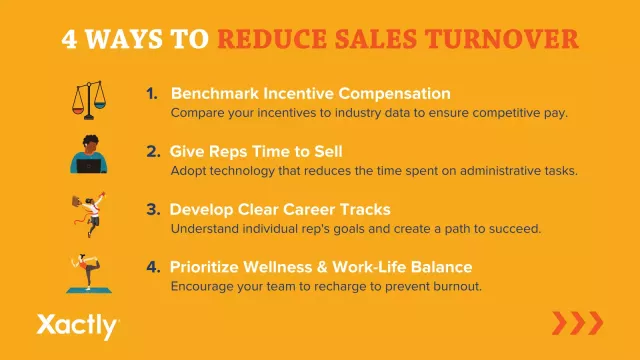Employee turnover is a challenge every organization faces, and in a world that has flipped to remote working and hybrid almost overnight, it’s become a bigger challenge. Selling can be done from anywhere in the world. As a result, the job market has become extremely competitive, with top talent being poached from every direction.
The Current Landscape: 10 Sales Turnover Statistics
1. Voluntary turnover is steadily increasing.
High voluntary turnover in sales can be detrimental to an organization. In our research, In Xactly’s survey of over 400 sales leaders, we found that sales organizations experienced a 58% higher employee turnover rate in 2021 than in the 12 months prior. Voluntary turnover often leaves organizations having to fill the gap until the role has been filled. Investing in methods to support employees can help reduce voluntary turnover.
2. Voluntary sales departures were highest among specific industries.
In the same Xactly study on the sales talent crisis, we found that technology and software companies had 67% more reps leave than others. Why? Remote working and virtual meetings made it possible for sellers to do their job from anywhere. As recruiting teams realized this, it became much easier for salespeople to find new job opportunities.
3. Sales organization turnover is nearly 3x higher than any other organizations.
HubSpot reports the average rep turnover is 35 percent, which is higher than the average for all other industries at 13 percent. SiriusDecisions data also shows that almost half (45 percent) of B2B sales organizations have average turnover rates above 30 percent. It’s because of the competitive nature of sales. As companies grow, their need for additional salespeople also increases. Now that sellers can work from almost everywhere, the competition for talent has skyrocketed.
4. The biggest tech companies have high turnover rates.
The average sales rep tenure is 18, months according to HubSpot. This is troubling. Xactly Insights data shows that sales reps hit their peak performance between two and three years in their role. That means most reps are leaving before they’ve reached their maximum potential.
Again, competitive recruitment is partly to blame, but there is also a generational factor. Younger employees, specifically Millennials and Gen Z, are more likely to job hop. Millennials entered the workforce during the recession. And many Gen Zers saw their parents lose jobs during the recession, which made them value job loyalty less than older generations.
5. It's expensive to replace any employee, let alone top performing sales reps.
Every new rep will go through a ramp up period, which is the amount of time it takes a new salesperson to complete training and also reach full productivity. It takes an average of 3.2 months for new salespeople to ramp up to full productivity. If the average tenure is 18 months, that leaves you with less than a year and a half before you’re paying those replacement costs again.
6. There is a lengthy time period to fill an open sales role.
A joint survey conducted by Sciolytix and SellingPower, found that filling a business-to-business sales position will take on average 60 days and probably longer. Even with the standard 2 week resignation notice, sales organizations would have upwards of 46 days working with limited human capital.
7. A “bad” sales hire can cost a company millions.
This Forbes study explains how losing 25% or more of their sellers every quarter is pretty common and just a 5% increase in sales rep attrition across your sales team can increase selling costs 4-6%. The difference between a 5% attrition rate and 25% means an increase of over 50% in cost to sell and revenues drop by 20%. This proves that replacing sales rep significantly affects the bottomline of an organization.
8. Good management is essential.
Quality management can make or break the relationships within sales organizations. Xactly research found that 15% of sales leaders assert they have changed their job in the last 2 years due to lack of good management. On the other hand, 26% of sales leaders who have not changed jobs in the last two years attribute their tenure to good management. The best way to assess quality management is to determine if your sales leaders are feeling supported by management, and are being given all of the tools to be successful.
9. There's no near end in sight for The Great Resignation.
According to the Achievers' 2022 Engagement and Retention Report, 66% of employees say they might job hunt over the course of the year. The research suggests no end in sight for what the Achiever’s referred to as the Great Resignation. Employees are constantly on the hunt for the next big thing. Now more than ever incentives are crucial.
10. Turnover is directly affected by company culture.
Qualtrics research found that 56% of job seekers agree they would not consider working for a company that has values they do not agree with. Additionally, according to CNBC/Momentive research, 40% of workers say they would go as far as to quit their current job if their organization took a political stance they disagree with. With this in mind, aligning your hiring with your company goals can help lower turnover in the long run.
Reasons Why Salespeople are Leaving
There are several reasons sales reps choose to leave their job. Over the past year, this list has expanded to include more work-life balance needs and wellness. Here are the top five reasons salespeople (and non-sales employees) are leaving.
1. Limited Work-Life Balance and Culture
According to Xactly’s Great Resignation research, 20% of employees who changed jobs over the past two years did so due to seeking a better work-life balance. The Harvard Business Review refers to this phenomenon as The Great Exploration — one in which people are being awakened to new possibilities for their professional lives.
2. Low Job Satisfaction & Engagement
Also according to the Achievers' 2022 Engagement and Retention Report, 79 percent of workers are disengaged at work to some degree. The pandemic played a huge role in the decrease in engagement as many workers had to bring children home and help with virtual learning while working full-time.
Hubspot also found that reps who spend four or more hours on selling activities are happier in their role. The problem is that the average sales rep spends less than one-third of their time on sales activities.
3. High Levels of Sales Burnout
Sales burnout has increased steadily over time. The pandemic increased burnout after many transitioned to work from home. While remote working did lead to more flexibility, it also led to employees working longer hours.
4. Unhappiness with Leadership
Xactly data regarding the impact the Great Resignation is having on organizations explains that sales reps are staying, or leaving, organizations because of management. A study shows that in the last 2 years, 26% of people decided to stay at their current employer due to quality leadership in place.
Reducing Sales Turnover in Your Organization
You can’t entirely eliminate sales turnover, but you can take steps to improve retention, including:
- Benchmark Your incentive Compensation: Comparing your sales incentive to industry data will help you ensure that you developing compensation strategies that are competitive and allow you to attract and retain top performers.
- Give Reps Time to Sell: Reps that spend more time selling are happier, more engaged, and perform better. Technology can help reduce the time reps spend on administrative tasks and increase the time they spend selling.
- Develop Clear Career Tracks: Spend one-on-one time with reps to understand their career goals and create a clear path for them to advance in their career. This will make your team strong and keep them more engaged.
- Prioritize Wellness and Work-Life Balance: The focus on wellness is here to stay. Encouraging salespeople to take time to recharge prevents burnout, keeps engagement high, and increases your sales retention.
To learn more ways to improve your sales retention, download the “Sales Talent and The Great Resignation: What did we learn?.”


